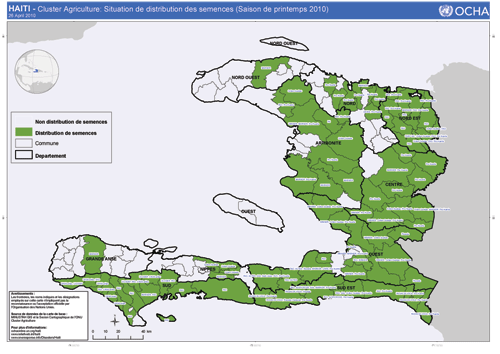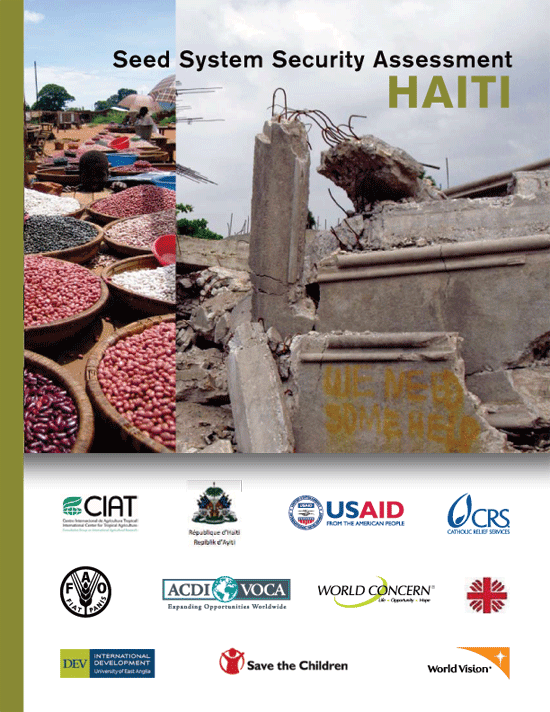Seeding reconstruction? series
Part 2 - Seed emergency or chronic crisis?
Posted March 30, 2011
Part 2 of 5
The Agriculture Cluster did not get the full $70,640,554 it requested for 26 emergency projects, only $31,526,150.
“Donors have been very generous, and we are thanking them for all they did,” the FAO’s Francesco Del Re, coordinator of the Cluster, told Haiti Grassroots Watch in a recent email, but “their response was far from covering the needs” of the Cluster and the Haitian Ministry of Agriculture (MARDNR).
About $20 million went for the distribution of seeds, plant cuttings and tools, according to Del Re. While the exact numbers vary, according to the FAO, for the spring season alone, 2,534 MT (metric tons) of legumes and cereal seeds were handed out by Cluster members.
 Agriculture Cluster map showing seed distribution for spring, 2010.
Agriculture Cluster map showing seed distribution for spring, 2010.
“The logic behind [the distribution] is that in the zones directly affected by the earthquake and in the zones that received a great number of displaced people, the peasants were decapitalized,” Del Re told Haiti Grassroots Watch. “It wasn’t a general distribution. It was a well-targeted distribution, for the most vulnerable.”
In addition to the directly affected areas, the Cluster wanted to support the farming season in general, “to maximize food availability at a difficult moment,” Del Re told Haiti Grassroots Watch in a follow-up email.
In all, 395,000 families – perhaps one-third to one-half of Haiti’s farming population – were reached during 2010.
While the MARDNR didn’t coordinate the distributions, it did define a list of acceptable seeds. Importing new varieties of seeds and plants, without proper controls and tests, can lead to failures in the field and to the contamination of native strains. (It is also illegal, according to Haitian law, the World Trade Organization and international conventions to which Haiti is party.)
(Nevertheless, with the approval of Minister of Agriculture of Haiti Joanas Gué, the US-funded WINNER project distributed previously unused varieties like hybrids from PIONEER and MONSANTO. [See Monsanto in Haiti])
According to the MARDNR, Haitian farmers need about 11,220 MT of cereal and bean seeds each spring, meaning that according to Cluster statistics, at least 23 percent of seed needs – and probably more, since not all organizations coordinate with the Cluster – were covered for that season.
“Seed emergency” or a “chronic” problem?
But not all experts agree that Haiti faced a “seed emergency” last year.
Indeed, Del Re admitted, there are “some very strong (and fixed) opinions” and “as we are speaking, there is a very open debate over the best way to subsidize/support the Haitian agriculture.”
One of those with a strong opinion – on seeds and seed aid, at least – is Louise Sperling, Principal Researcher at the International Center for Tropical Agriculture (CIAT).
The researcher came to that conclusion while working on the 115-page Seed System Security Assessment/Haiti (SSSA) report [PDF], which looked at the impact of the earthquake on households and agriculture livelihoods, as well as on seed security issues.

The report, released in August but whose main findings and recommendations were distributed to Cluster members in June, was funded by US AID and carried out with the cooperation of the MARDNR, the FAO, and several large development institutions.
Sperling and her co-authors noted that the “farmers eating their seed” phenomenon was not a “seed emergency.”
“Unlike nearly everywhere else in the world, ‘eating and selling one’s seed’ are not distress signals in Haiti: They are normal practices,” the authors noted.
So there was no “seed emergency.” Instead, farmers faced “financial constraints” (lack of cash, lack of credit) and the “deeply chronic” challenges with Haiti’s seed system.
Indeed, Sperling who has worked in over 20 African countries for almost three decades, dealing with war, drought, and genocide, thought she had seen it all. Until she came to Haiti.
“I am not sure I have ever seen so little innovation,” she told Haiti Grassroots Watch in a lengthy interview via internet from Tanzania. “Small farmers have been left behind on a massive scale.”
For Sterling and the other contributors to the SSSA, the “direct seed distribution” was a poor policy choice, because it should only occur when there is a lack of seed available. In Haiti, even after the earthquake, there was adequate – albeit often genetically inferior – seed, via the informal marketplace and in some cases, via commercial providers.
[T]he type of aid response often did not match the seed security problem at hand: the immediate problem was clearly one of financial stress, which can lead to problems in accessing a range of goods, including seed. Direct seed availability was not identified as a significant constraint.
Part 2 of 5
What did Haiti Grassroots Watch investigations turn up?
Should seed distributions continue?
Read Part 3 - Seed Distribution: What do farmers and the SSSA recommend?
See also Monsanto in Haiti
Go to Seeding Reconstruction or Destruction? summary and the video

